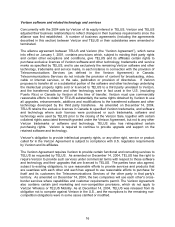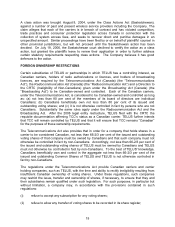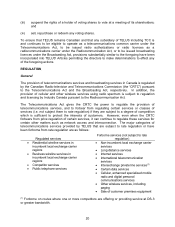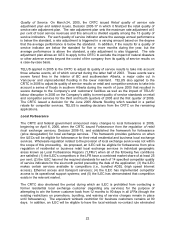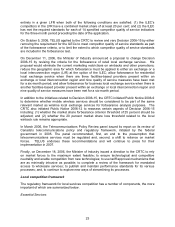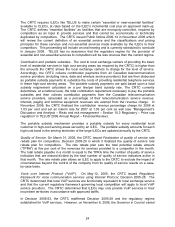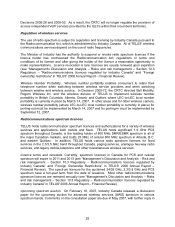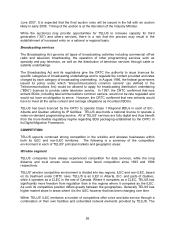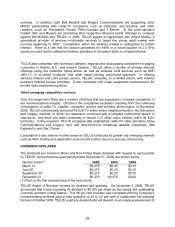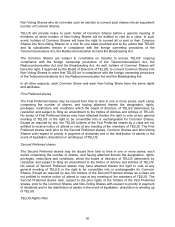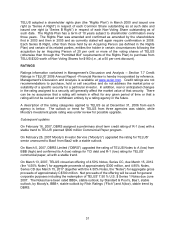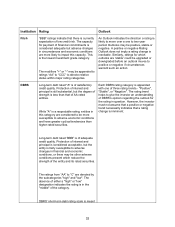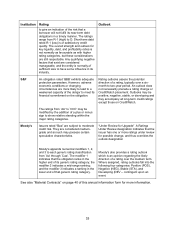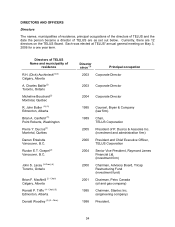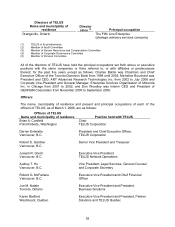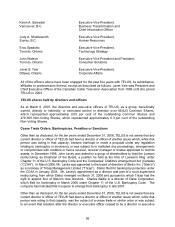Telus 2006 Annual Report Download - page 27
Download and view the complete annual report
Please find page 27 of the 2006 Telus annual report below. You can navigate through the pages in the report by either clicking on the pages listed below, or by using the keyword search tool below to find specific information within the annual report.June 2007. It is expected that the final auction rules will be issued in the fall with an auction
likely in early 2008. Timing of the auction is at the discretion of the Industry Minister.
While the auction(s) may provide opportunities for TELUS to increase capacity for third
generation (“3G”) and others services, there is a risk that the process may result in the
establishment of increased entry on a national or regional basis.
Broadcasting services
The Broadcasting Act governs all types of broadcasting activities including commercial off-air
radio and television broadcasting, the operation of other programming services such as
specialty and pay television, as well as the distribution of television services through cable or
satellite undertakings.
The Broadcasting Act and its regulations give the CRTC the authority to issue licences for
specific categories of broadcasting undertakings and to regulate the content provided and rates
charged by each category of broadcasting undertaking. In August 1996, the federal government
issued its policy under which “telecommunications common carriers” (as defined in the
Telecommunications Act) would be allowed to apply for broadcasting distribution undertaking
(“BDU”) licences to provide cable television service. In 1997, the CRTC confirmed that new
entrant BDUs, including telecommunications common carriers, would not be rate regulated and
would not have an obligation to serve. However, the CRTC confirmed that new entrants would
have to meet all the same content and carriage obligations as incumbent BDUs.
TELUS has been licenced by the CRTC to operate Class 1 Regional BDUs in each of B.C.,
Alberta and Québec utilizing its IP facilities. TELUS also holds a national licence to operate a
video-on-demand programming service. All of TELUS’ services are fully digital and thus benefit
from the more flexible regulatory regime regarding BDU packaging established by the CRTC in
its Digital Migration Framework.
COMPETITION
TELUS expects continued strong competition in the wireline and wireless businesses within
both its ILEC and non-ILEC territories. The following is a summary of the competitive
environment in each of TELUS’ principal markets and geographic areas:
Wireline segment
TELUS companies have always experienced competition for data services, while the long
distance and local access voice services have faced competition since 1993 and 1998
respectively.
TELUS’ wireline competitive environment is divided into two regions, ILEC and non-ILEC, based
on its treatment under CRTC rules. TELUS is an ILEC in Alberta, B.C. and parts of Québec,
while it operates as a CLEC in the rest of Canada. Where it competes as a CLEC, TELUS has
significantly more freedom from regulation than in the regions where it competes as the ILEC.
As such its competitive position differs greatly between the geographies. Generally TELUS has
higher market share in areas where it is the ILEC however that has been changing over time.
Within TELUS’ ILEC territories a number of competitors offer voice and data service through a
combination of their own facilities and unbundled network elements provided by TELUS. The
26


